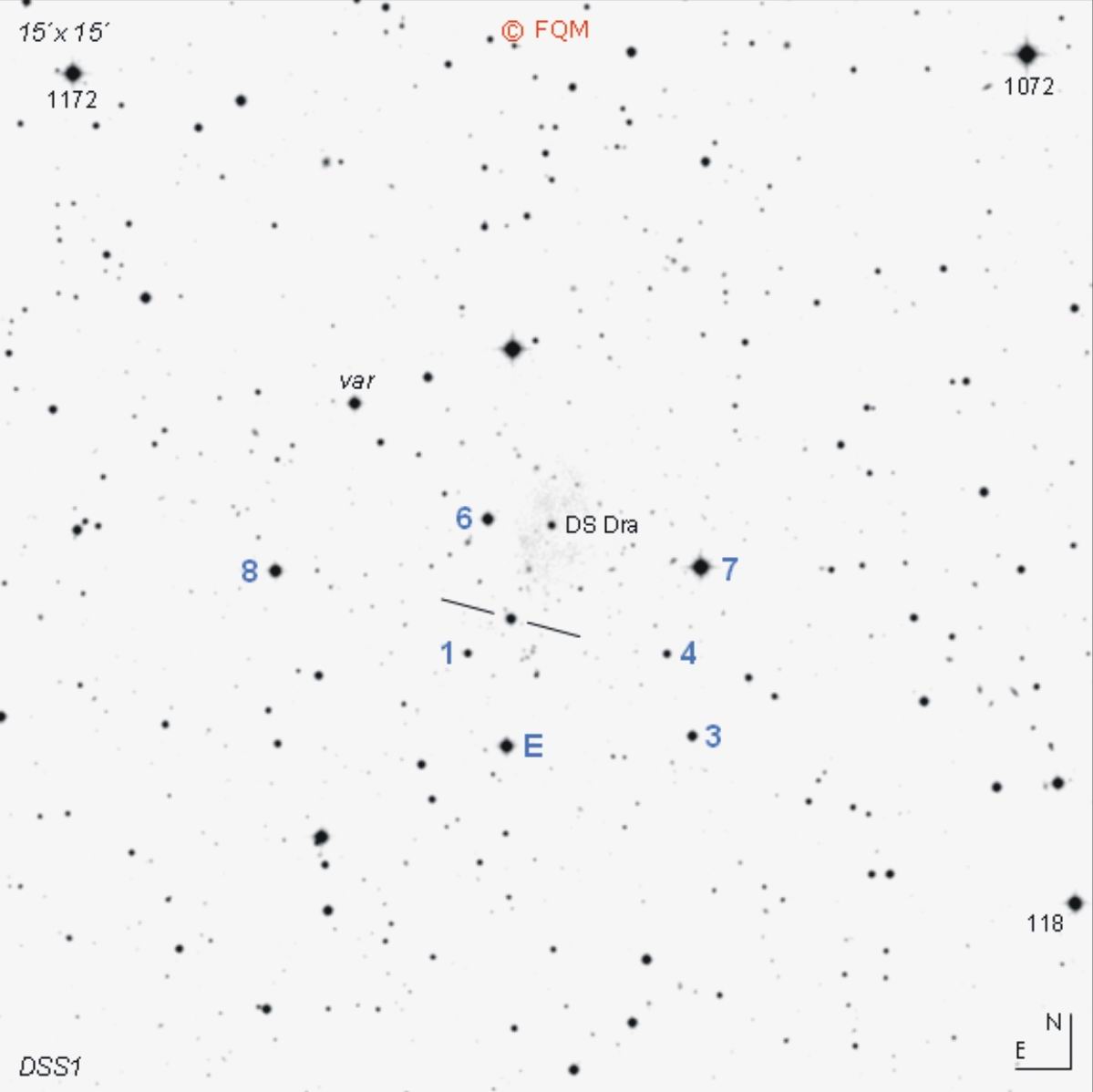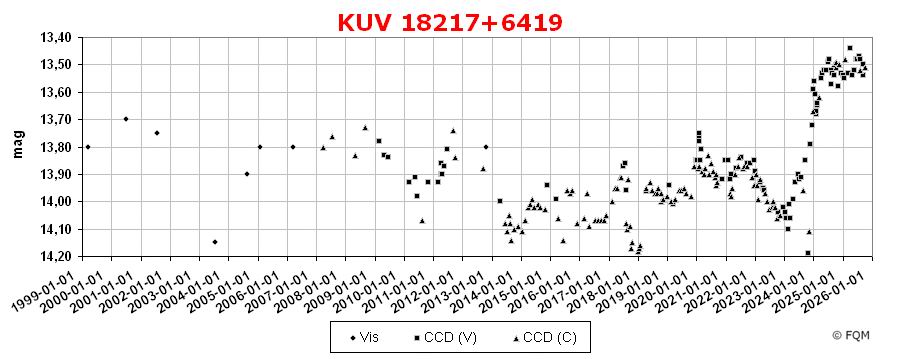
| Frankfurt Quasar Monitoring |
| KUV 18217+6419 |
| Cross-Identifications | 1ES 1821+643, E 1821+643, PG 1821+643 IRAS 18216+6418, H 1821+643, 1821+643 1RXS J182157.4+642051, EXO 1821.6+6419 7C 182140.90+641929.00, 1H 1820+643 SWIFT J1822.1+6421, QSO B1821+6419 RGB J1821+643, RX J1821.8+6419 PLCKESZ G094.01+27.42, 2E 4066 |
| Equat. coordinates | RA 18 21 57.2 DE +64 20 36 (J2000) |
| Constellation | Draco |
| Type | QSO |
| Redshift | z=0.297 |
| Distance (2) (3) | 1141 Mpc |
| Total mag range (mv) (4) (5) | 13.3 - 14.2 |
| Catalog Magnitude (1) | 14.24 |
| Absolute Magnitude (1) | -27.1 MB |
| Light Travel-Time (2) | 3.269 × 109 yrs |

Comparison stars
| star | B | V | Rc | Ic (1) |
| 1 | 16.344
(0.036) |
15.458
(0.019) |
14.941
(0.008) |
14.493
(0.015) |
| 3 | 15.629
(0.022) |
14.432
(0.013) |
13.721
(0.007) |
13.138
(0.011) |
| 4 | 16.520
(0.036) |
15.576
(0.019) |
15.046
(0.011) |
14.560
(0.017) |
| 6 | 14.149
(0.018) |
13.314
(0.011) |
12.839
(0.011) |
12.418
(0.009) |
| 7 | 11.851
(0.019) |
11.372
(0.013) |
11.060
(0.006) |
10.779
(0.010) |
| 8 | 13.357
(0.019) |
12.799
(0.012) |
12.450
(0.006) |
12.146
(0.009) |
| E | 13.160
(0.019) |
12.524
(0.012) |
12.141
(0.005) |
11.807
(0.009) |



| KUV 18217+6419
is a bright quasar in Draco and is one of the brightest objects of its
class. This stellar object was discovered in 1977 as an X-ray source by the HEAO1
satellite (H). With the same property it was observed again in 1980 by the Einstein
satellite (E) with higher
precision. In 1981, a stellar object of v=14.1 m was found as
the optical counterpart. Follow-up spectroscopic investigations
revealed a Seyfert 1-spectrum,
which led to the quasar classification. Just one year
earlier, this quasar was
found independently in the optical
(v=14.24 m) by the KISO-Survey (KUV), searching for UV-bright stellar
sources. The host galaxy of quasar KUV 18217+6419 is a giant elliptical galaxy, also classified as a Hyperluminous Infrared Galaxy (HyLIRG). The quasar host resides at the centre of galaxy cluster CL 1821+643 (see image above). Quasar KUV 18217+6419 is one of the most luminous radio-quiet quasars in the area of z<0.5, and the second brightest quasar of all at z>0.1. Quasar KUV 18217+6419 is a small amplitude variable object with a total range of only about one magnitude (13.3 - 14.2 m). CCD observers, as well as visual observers, shall use the comparison stars given above. Visual observers need at least an 8- to 10-inch telescope to glimpse this stellar object. ____________
Quasar KUV 18217+6419 is located only 1´SE of planetary nebula PK
94+27.1 (= K1-16), which can only be observed
with large aperture telescopes under very
dark skies. The bluish central star is a lot easier to detect at v=15.04 (GCVS) / v=15.055 (Doroshenko 2005) / 14.9 m (GSC) (see
image above). It is listed with the designation DS Dra and is
considered to be
slightly variable by 0.02 mag. Another interesting deep sky object can be found some 3° to the south. There we find the showpiece planetary NGC 6543, also known as the "Cat´s Eye Nebula". NGC 6543 is rich in details and one of the brightest objects of its class. Observers who like to continue testing their skills may turn to BL Lac object 3C 371, a bright 14-mag object at a distance of about 0.6×109 light-years, 5.7° NNW of KUV 18217+6419. |
| Beyvers, G., Beyvers, C. 2001, SuW 9/01, 773; Quasare im Sechs- und im Achtzöller. de Grijp, M.H.K., Miley, G.K., Lub, J. 1987, A&AS, 70, 95; Warm IRAS Sources - A Catalogue of AGN Candidates from the Point Source Catalogue (PSC). Doroshenko, V.T, et al. 2005, Ap, 48, 304; BVRI CCD-Photometry of Comparison Stars in the Neighborhoods of Galaxies with Active Nuclei. II. Fried, J.W. 1998, A&A, 331, 73; Extended Emission-Line Gas in the High Luminosity, Low Redshift QSO E1821+643. Hall, P.B., Ellingson, E., Green, R.F. 1997, AJ, 113, 1179; X-ray Emission from the Host Clusters of Powerful AGN. Hutchings, J.B., Neff, S.G. 1991, AJ, 101, 2001; Optical Imaging of the Low Redshift Superluminous QSO 1821+643. Hynes, S.J.; Planetary Nebulae; Richmond, VA.; Willmann-Bell 1991. Karge, S.; Helle Quasare für 8- bis 10-Zoll Teleskope. Ein Beobachtungsführer zur visuellen Beobachtung von Quasaren und BL Lacertae Objekten; Frankfurt 2005. Kirhakos, S.D., Sargent, W.S.W., et al. 1994, PASP, 106, 646; The HST Quasar Absorption-Line Key Project. VIII. CCD Imaging of Hubble Space Telescope Quasar Fields. Kolman, M., Halpern, J.P., et al. 1991, ApJ, 373, 57; The Ultraviolet Spectrum and Continuum Energy Distribution of the Bright Quasar H1821+643. Noguchi, T., Maehara, H., Kondo, M. 1980, Ann. Tokyo Astr. Obs., 18, 1; A Search for Ultraviolet-Excess Objects. Pravdo, S.H., Marshall, F.E. 1984, ApJ, 281, 570; Soft X-Ray Aktive Galactic Nuclei. Schneider, D.P, Bahcall, J.N., et al. 1992, AJ, 103, 1047; The Cluster of Galaxies associated with the Low-Redshift Quasar H1821+643. Steinicke, W.; Beobachtungsliste für helle Quasare; Umkirch 1999. Véron-Cetty, M.-P., Véron, P. 2001, A&A 374, 92; A Catalogue of Quasars and Active Nuclei: 10th edition. Véron-Cetty, M.-P., Véron, P. 2003, A&A 412, 399; A Catalogue of Quasars and Active Nuclei: 11th edition. Véron-Cetty, M.-P., Véron, P. 2006, A&A 455, 776; A Catalogue of Quasars and Active Nuclei: 12th edition. Véron-Cetty, M.-P., Véron, P. 2010, A&A 518, 10; A Catalogue of Quasars and Active Nuclei: 13th edition. Wegner, G., Africano, J.L., Goodrich, B. 1990, AJ, 99, 1907; Photoelectric Photometry for 106 Objects in the KISO Survey. |
| Links: Hamburg Quasar Monitoring Image by WIYN Observatory PK 94+27.1 & KUV 18217+6419: drawing by Uwe Glahn |
| home |